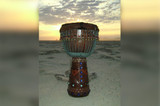Which Mallets are Right for Me?
There are as many mallets to choose from as there are keys on a marimba, and really, there are probably more than that. For anyone who is just getting into the wonderful world of idiophone percussion instruments, like the marimba, xylophone or vibraphone, you’ve probably already realized there is a lot more to these instruments than you first thought. Most percussion instruments are seen similarly – after all, how hard can it be to bang something to make a sound?
It’s not easy. In fact, even trying to figure out the best tool to use to hit the instrument is pretty difficult at first. There’s a science behind it all, so before you run off and hit your new xylophone with a brass mallet, keep in mind that the right mallet isn’t necessarily about your needs, it is about your instrument’s needs, the venue in which you are playing, and the whole feel of the music you are playing. So much for being easy.
Xylophone mallets typically do not have any sort of padding or wrapping around the “core.” These are the mallets that are best described as rubber or acrylic balls attached to the end of a thin, stiff shaft. Xylophone mallets can also come in brass, nylon or wood varieties in order to fully take advantage of the instrument’s natural timbre.
Marimba mallets are a bit more versatile than xylophone mallets, for different reasons. Marimbas have built-in resonators that increase the richness and volume of the wooden keys, both of which require a softer touch with a lot of power behind it. You’ll find these in either the rubber ball variety, or in the number of wrapped yarn or cord marimba mallets, with varying types of wood used for the shaft for flexibility and resonance.
Vibraphone mallets are usually cord-wrapped, with soft, medium and hard cores to please even the pickiest of players. Like the marimba, a vibraphone has resonators that increase the volume and the tone of the instrument and with the harder wrapping from cord, there is a cleaner sound that takes full advantage of the instrument’s overall design.
It isn’t just the head, or the core of the mallet that is important when you’re playing the xylophone, marimba or vibraphone. The shaft of the mallet plays an important role, as well. The flexibility of the shaft is a big part of what determines the sharpness of the notes being played. When you start playing your instrument with more than one mallet in each hand, this flexibility can become even more important as you are less able to tightly grip each mallet. Most mallet shafts are made from birch or rattan, especially for marimbas or vibraphones. Xylophone mallets have a wide variety of materials used in the shaft, from plastics and acrylics to bamboo or the standard birch or rattan.
As with any instrument, you’ll be given plenty of advice on what is the best tool for your job as a musician. When it comes to the best mallet for your performance or practice, by keeping any “damage control” issues in mind, you should just expect to experiment with the different mallets available until you discover your favorite sound. Then, be ready to keep changing what works best for you as you increase your ability to play the instrument, find new places to play it or the different needs of those playing with you.
Recent Posts
-
What is the Best Size Djembe for Beginners?
If you're new to the world of percussion and interested in learning the djembe, you're in for a t …16th Jul 2024 -
The Benefits of Becoming a Drumming Teacher: Transforming Passion into Profession
Why become a drumming teacher? Becoming a drumming teacher is an excellent way to share your pas …22nd May 2024 -
What Makes the Djembe Drum a Spiritual Instrument in African Music?
Origin and history of the Djembe drum The Djembe drum originates from West Africa and holds sign …16th May 2024



